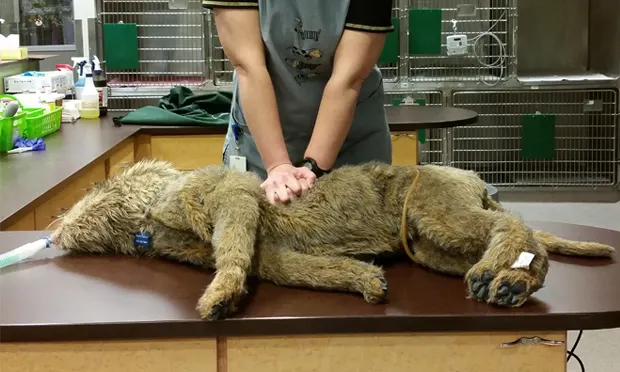Refreshing Your CPR Skills
Leslie Wereszczak, LVMT, VTS (ECC), University of Tennessee

A well-trained team, coupled with the essential tools to carry out a cardiopulmonary resuscitation (CPR) effort, is imperative to increase the potential for a positive outcome for veterinary CPR.
Researched evidence overwhelmingly supports that CPR success rates for humans improve with repeated standardized training.1 CPR training and certification is standard among human healthcare professionals; however, veterinary medicine has less stringent expectations. The Reassessment Campaign on Veterinary Resuscitation (RECOVER) was launched in 2012 to provide evidence-based, veterinary-specific guidelines to improve CPR outcomes. Following is CPR advice based on RECOVER.
The Resuscitation Area
Assemble CPR equipment and medications in a central area designated for use only in crisis situations.
Use a daily checklist to confirm that all commonly used CPR medications are present and in-date, and that equipment is present, organized, and functioning.
Ensure all team members potentially involved in a CPR effort are proficient in the use of all equipment.
Ensure that resuscitation charts are within clear view of the resuscitation area, including pre-calculated drug dosages to minimize mistakes and eliminate the need for time-consuming dose calculations during CPR.
Try to initiate the CPR effort in a location that maximizes its potential effectiveness; however, chest compressions should always begin immediately. This may be cage-side, although moving the patient to the crash area may be the best option in some instances.
Practice Makes (Almost) Perfect
As with any skill, the more the team practices CPR, the more proficient the team will become. Since CPR is performed less frequently than most other tasks in veterinary practice, skills can deteriorate.
Run CPR drills on a regular schedule (every 3 to 6 months) with all team members who may potentially be part of any CPR effort so that administering CPR becomes second nature.
Using a veterinary-specific CPR mannequin for training is ideal; however, improvising with a stuffed animal is acceptable.
Algorithm charts will give team members prompts for the next step during CPR. Assign all team members specific duties. If enough team members are available, a different member should perform each of the following:
intubate and provide ventilation
attach monitoring equipment, obtain venous access if not present already, and administer drugs
record all information and keep track of time
act as team leader, observing and giving directions
perform chest compressions.
At the 2-minute interval, the chest compressor should swap duties with another team member (eg, the person providing ventilation).
Basic & Advanced Life Support
Begin basic life support (BLS) (ie, the recognition of cardiopulmonary arrest, establishment of the airway, and the delivery of ventilation). Chest compressions should be started immediately when cardiac arrest is suspected. Compress the chest one-third to one-half its width, with compressions delivered at a rate of 100 to 120 per minute, allowing full recoil of the chest wall between individual compressions.
Chest compressions should be performed for a cycle of 2 minutes, without interruptions for ECG viewing, intubation, or IV catheter placement. A brief (ie, <10 second) assessment of the ECG may be obtained after several cycles of chest compressions have been completed. (Note: Fatigue from performing compressions for longer than 2 minutes can affect compression quality and potential outcome; therefore, chest compression providers should be swapped out at 2-minute intervals.)
Perform endotracheal intubation, inflate the cuff, secure the tube, and initiate ventilation at 10 breaths per minute, with a 1-second inspiratory time and 10mL/kg tidal volume.
Advanced Life Support (ALS) begins after BLS has been established and the need for anticholinergics, vasopressors, positive inotropes, defibrillation, and other critical needs are determined.
Team Effort
With a success rate of about 6%,1 it is important that the chances of running a well-orchestrated CPR effort is optimized by making sure that any team is well prepared to respond immediately and competently to any arrest situation. This is achieved through readiness and practice. Challenge your team to be ready!